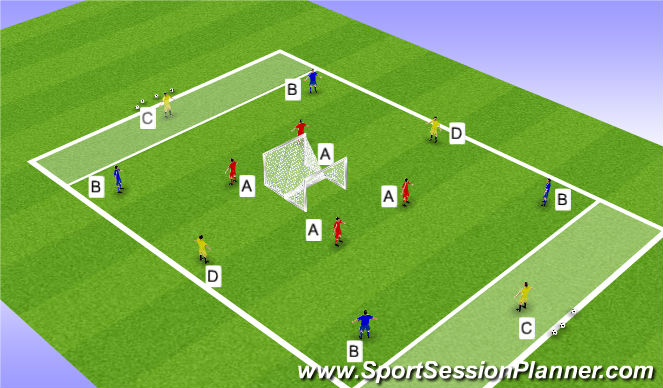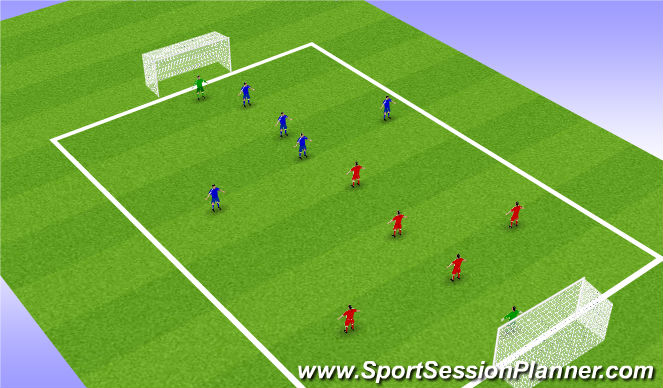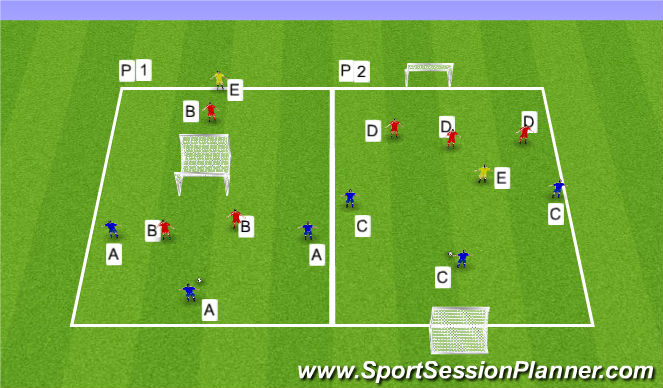Football/Soccer Session (Beginner): Possession & Pressing Triggers U8-U11
Profile Summary

| Name: | Christopher Ruiz |
|---|---|
| City: | Lutz |
| Country: | United States of America |
| Membership: | Adult Member |
| Sport: | Football/Soccer |
Description
SESSION OBJECTIVES
In possession:
• Develop positioning in order to create space
• Develop decision-making: play forward or circulate possession?
Out of possession:
• Improve identification of pressing triggers
PART 1: SMALL-SIDED GAME
• Two varieties of small-sided games are designed to develop players’ understanding of how to maintain effective possession while always incentivising playing forward and looking for opportunities to score.
• Both games encourage the defensive teams to defend in different ways depending on the game state and situation
PART 2: POSSESSION GAME
• This practice is designed to develop players’ positional understanding – recognising specifically how to support the ball effectively and how to create space in order to maintain effective possession.
• The practice also teaches players to defend compact and together, while looking for triggers and opportunities to press the ball.
• The practice encourages problem-solving and communication across both teams.
PART 3: SMALL-SIDED GAME
• The practice challenges teams to develop their strategy to defend and attack in different ways depending on the game state.
• It challenges players to make effective decisions and remain composed under intense pressure

See the guidance at the top of this page to understand why you are not seeing interactive Football/Soccer images.

SSG Possession 4v4 + 4 (20 mins)
Function
• This is a 4v4 + 4 game, which is adaptable depending on numbers.
• Two outside end players (C) can be goalkeepers and are permitted an extra six yards if they need it to drop and support the ball. However, they can still be pressed.
• Two wide players (D) play inside the area at all times.
• Teams can score in either of the back-to-back goals or make 10 passes to score.
• Once a team scores in one of the goals, they need to make 6 passes (or a set amount from coach) to keep the goal. Failure to do so equals no goal; score again within another 6 passes and the goal counts double.
COACHING DETAIL: IN POSSESSION
CREATING SPACE & DECISION-MAKING
• Make the pitch big: use the width and encourage players to be brave and stay away.
• Opposite-side players should stay away; this creates extra numbers to maintain possession or score on one side. If opponents press with more numbers, it gives the team in possession an overload on the other side if they switch play.
• Look for the goal first. If a goal can’t be scored, find the free player.
• If the defending team are compact, move the ball to shift the defenders and create gaps to score. • Have patience; trust the process and stay composed.
• Decision-making: recognising when to play through, round or over the opposition.
• Tight technical detail linked to receiving skills: half-turn or protect and spin?
COACHING DETAIL: OUT OF POSSESSION
COMPACT DEFENDING & IDENTIFYING TRIGGERS
• Work together, remain compact and defend the goal.
• Recognise how to use all defenders effectively. Ask the players to work out what the best distribution of defenders is depending on the type of pitch and goal position.
• Identify triggers to press: bad pass, bad touch, ball on the outside. When you see them, press together.
• Use of body to direct play and force the ball on one side, into the touchline. Support and cover behind to affect the next pass.

See the guidance at the top of this page to understand why you are not seeing interactive Football/Soccer images.

SSG Pt2 5v5 +Gks (25 mins)
Function
• This is a normal 6v6 game with a twist.
• If a team scores and then proceeds to keep the ball for 6 passes, then they keep their goal.
• If they score again within another 6 passes, that goal counts for double.
• If the challenge is not completed, that equals no goal.
PROGRESSION
• Make it so that 8 passes in open play is also a goal.
• Increase the number of passes needed for a goal to count.
• Change the pass count to time in possession. For example, keep the ball for 8 seconds for a goal to count.
COACHING DETAIL
PROBLEM SOLVING: TEAM DISCUSSSIONS
• Encourage players to discuss how to solve the different challenges that the game confronts them with.
• Play blocks of four or five minutes to ensure intensity is high, then get players in a group to discuss how they can be effective once they score and how they are going to defend once they concede.
• If they’re winning the game, how does this change the way they attack or defend? Do they defend deeper and more compact, or still press high?
GAME MANAGEMENT
IN POSSESSION
• Risk v reward: once you’ve scored 6 passes, allow the team to keep the goal or score again for a second goal.
• Important for the players to recognise the state of the game. If there is space to exploit, go and score again. If not, they need the composure to handle the ball under pressure.
• Focus on decision-making to find the spare player and play through, round or over depending on how the defending team is pressing.
• Focus on the in-possession team’s movement to create space. ‘Open the pitch’ (width), stretch the games (depth) and have players ‘connecting’ to support the ball.
OUT OF POSSESSION
• Once you concede, how does it change the way you defend to stop the opposition making 6 passes? Do you just run after the ball straight away, and try to win the ball off the first pass? Or are you smart to still work together to win the ball?
• Work on a defensive strategy that can be used in a normal game: defending compact. Look to force the ball one way and look for triggers to press, such as: ball in wide area, bad pass or poor touch.
• Defensive strategy once conceded: win the ball back as soon as possible. First player dictates and directs the play. Force the opponents to where you have supporting players and be aggressive to force mistakes. Work together, not individually!








 Play animation
Play animation Play step-by-step
Play step-by-step Repeat (toggle)
Repeat (toggle) Full Screen
Full Screen Pause
Pause Stop
Stop
SSG Pt1 3v3 +1 (15 mins)
FUNCTION
• This is a 3v3 tournament that can be adapted depending on numbers. • Every team plays each other once in three-minute games on both pitches. Keep scores: 3 points for a win, 1 point for a draw.
• Pitch 1 uses back-to-back goals. A team scores in either goal or makes 8 passes for a point, although you can adapt the number of passes depending on age or ability. A ‘magic man’ (E) can be used on either pitch.
• Pitch 2 uses a regular pitch with mini goals. If a team scores and then proceeds to keep the ball for 5 passes, they keep their goal; if they score again within another 5 passes, that goal counts for double. If the challenge is not completed, that equals no goal.
PROGRESSION
• Pitch 1: If a team scores in either goal, they then proceed to keep the ball for a set amount of passes to keep their goal; if they score again within 5 passes, that goal counts for double. If the challenge is not completed, that equals no goal.
• Pitch 2: Set amount of passes in open play, determined by age and ability of the group, also counts as a goal.
COACHING DETAIL: IN POSSESSION
CREATING SPACE & DECISION-MAKING
• Make the pitch big: use the width and encourage players to be brave and stay away.
• Opposite-side players should stay away; this creates extra numbers to maintain possession or score on one side. If opponents press with more numbers, it gives the team in possession an overload on the other side if they switch play.
• Look for the goal first. If a goal can’t be scored, find the free player.
• If the defending team are compact, move the ball to shift the defenders and create gaps to score.
• Have patience; trust the process and stay composed.
• Decision-making: recognising when to play through, round or over the opposition.
• Tight technical detail linked to receiving skills: half-turn or protect and spin?
COACHING DETAIL: OUT OF POSSESSION
COMPACT DEFENDING & IDENTIFYING TRIGGERS
• Work together, remain compact and defend the goal.
• Recognise how to use all defenders effectively. Ask the players to work out what the best distribution of defenders is depending on the type of pitch and goal position.
• Identify triggers to press: bad pass, bad touch, ball on the outside. When you see them, press together.
• Use of body to direct play and force the ball on one side, into the touchline. Support and cover behind to affect the next pass